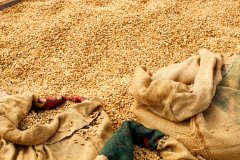African elevated scaffolding Solar treatment of Coffee beans in Claudia Manor, Colombia
Introduction to Antioquia, Colombia
Antioquia, Antioquia Department, is the birthplace of Colombia Coffee and Colombia Coffee Growers Federation (FNC). It is also an important coffee producing area with a planting area of 128000 hectares, ranking first among all producing areas. Coffee here is produced by cooperatives of large estates and small producers.
Colombia is the world's largest exporter of washed coffee beans and rarely sundries them.
African trestle solarization
African style elevated shed, although the cost is higher, but let coffee beans can keep ventilation space, air flow is more adequate. Therefore, as long as it is fixed, the quality of fermentation is much more stable than in the past.
Also, the elevated canopy means that coffee beans are not affected by dust, animal droppings, and moisture on the ground. Exquisite sun treatment, in fact, is to consume a lot of manpower.
From picking, turning, shifting beans up and down, focusing on drying speed to picking out uneven beans, none of them requires human effort. There are also a lot of details and techniques that need attention.
Claudia Manor Introduction
Claudia Estate is owned by a coffee producer who has established three coffee estates to produce coffee. These three estates are located in Colombia. This coffee producer attaches great importance to the environment and environmental protection. They founded an environmental protection organization called Coamar, which is committed to educating local farmers to continuously cultivate and take care of the natural resources of the region. In addition to protecting the environment, coffee beans can also have a better growing environment and improve the quality of life of the people in the region.
Villa Claudia is located in San Agustin, south of Huila province. Alfredo Claros, a 50-year-old second-generation coffee farmer, bought the land with his wife Herlinda Rodriguez 10 years ago and started his own coffee plantation.
With an altitude of 1800 meters and an area of about 6 hectares, the estate is a typical small coffee farmer with an annual production of 12,000 kg and mainly cultivated with Caturra.
Claudia Estate has been working with Colors of Nature since its inception to produce specialty coffee.
After harvesting, coffee cherries are first allowed to stand for 24 hours, followed by Shaza type sun drying to reduce sunlight heat, thereby extending the drying time by more than twice, and after 30 days, the moisture content is reduced to the ideal ratio.
Solarization of African trellises at Claudia Estate, Pova, Antioquia, Colombia
Colombia Antioquia Bolivar Finca La Claudia Natural African Beds
■ Country: Colombia/ Colombia
■ Production area: Antioquia/ Antioquia
■ Manor: Claudia Manor/ Villa Claudia
■ Altitude: 1650~1850 m
■ Breed: caturra
■ Treatment method: African trellises solarization treatment method
■ Flavor: Berry, passion fruit, mango, fruit bouquet, raisin, cranberry, spice sweetness, overall solid and full flavor.

Important Notice :
前街咖啡 FrontStreet Coffee has moved to new addredd:
FrontStreet Coffee Address: 315,Donghua East Road,GuangZhou
Tel:020 38364473
- Prev
Features and Flavors Sweet Coca Flavor
Koke Washing Station Koke Washing Station was established in 2011 and is located about 6 km southwest of Yirgacheffe Woreda town center at an altitude of about 1870-1900 meters. At present, there are 96 cooperative farmers in the treatment plant, all of which are inherited.
- Next

The flavor characteristics of Panamanian Shenqu Manor the difficulty of sun treatment
Introduction and flavor of the Shenqu Manor the Vulcan Valley next to the Balu volcano, the highest peak of Panama, is located on the hillside southwest of the town of Paso Anqiu, with coffee varieties such as Typica, Catuai, Caturra, Bourbon, San Ramon and Geisha. Although Shenqu Manor has a complete set of dry washing equipment, it washes beans.
Related
- Beginners will see the "Coffee pull flower" guide!
- What is the difference between ice blog purified milk and ordinary milk coffee?
- Why is the Philippines the largest producer of crops in Liberia?
- For coffee extraction, should the fine powder be retained?
- How does extracted espresso fill pressed powder? How much strength does it take to press the powder?
- How to make jasmine cold extract coffee? Is the jasmine + latte good?
- Will this little toy really make the coffee taste better? How does Lily Drip affect coffee extraction?
- Will the action of slapping the filter cup also affect coffee extraction?
- What's the difference between powder-to-water ratio and powder-to-liquid ratio?
- What is the Ethiopian local species? What does it have to do with Heirloom native species?

